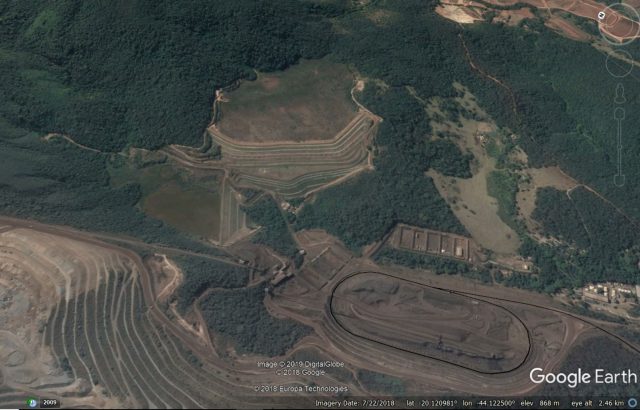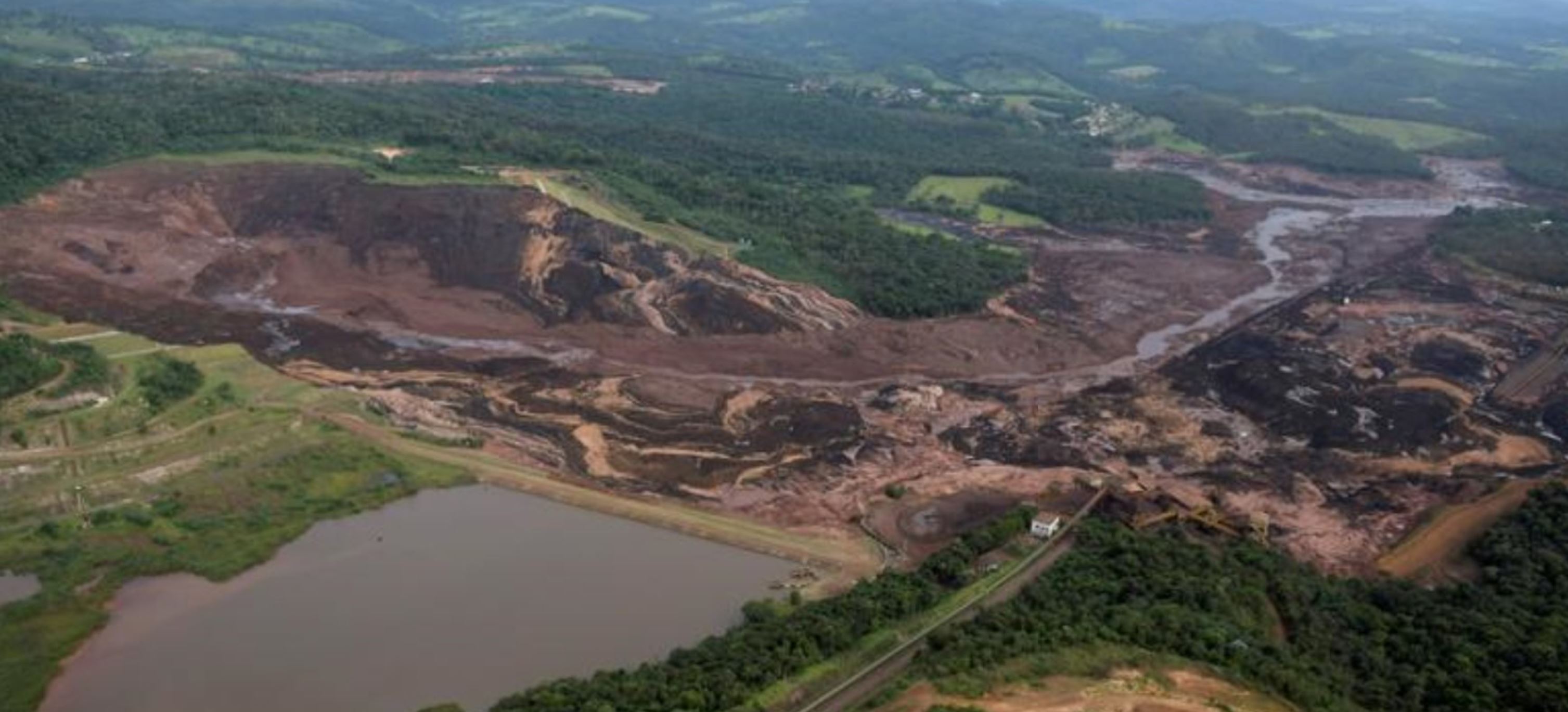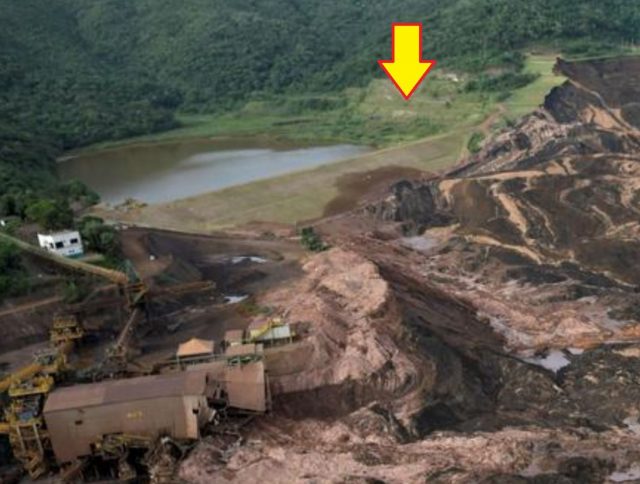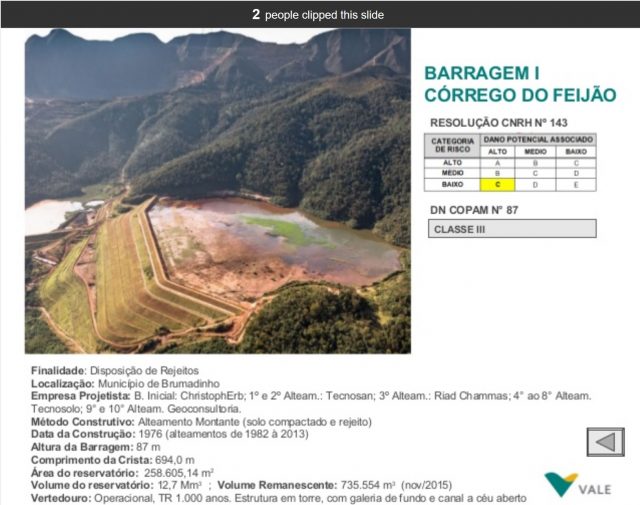27 January 2019
The scale of the tailings dam collapse at Feijão mine in Brumadinho, Brazil
Posted by Dave Petley
The scale of the tailings dam collapse at Feijão mine in Brumadinho, Brazil
The disastrous and tragic tailings dam collapse at Feijão mine in Brumadinho, Brazil is already fading from the attention of the international media, despite about 300 fatalities and a global-scale scandal. I will come back to the latter point below, but it is worth first examining the scale of the collapse at Feijão mine. The tailings dam that collapsed so dramatically is the one shown below, from Google Earth:-

Google Earth image of the tailings dam that collapsed at Brumadinho in Brazil on 25t January 2019.
.
This view appears to support the reports that the tailings pond was not in use at the time of the collapse – the vegetated pond shown above would seem to imply that tipping had ceased. As an aside, the second structure that is now considered to be at risk is shown in the centre left of the image.
The scale of the collapse is breathtaking. The image below was tweeted by John O’Leary:-

Image tweeted by John O’Leary showing the collapsed tailings pond at Brumadinho in Brazil.
.
This is clearly a complete collapse of the retaining structure, which was tall and steep, with most of the tailings having been mobilised into a high velocity flow. Note the complete destruction of the various buildings in the Google Earth image above, presumably accounting for the large numbers of fatalities.
The tweet by John O’Leary also shows the second dam that is considered to have a high potential for failure. This dam has been badly damaged, and the risk appears to be high:-

Image tweeted by John O’Leary showing the compromised tailings dam at Brumadinho in Brazil.
.
There is a presentation online showing the various tailings structures owned by Vale in this area, published in 2016. The tailings dam at Feijão mine in Brumadinho that collapsed is Slide 44 in the presentation:-

Vale assessment of the risk of the tailings dam that collapsed at Brumadinho in Brazil.
.
This assessment appears to indicate that the potential losses were assessed as being high should the dam collapse, but that the potential for this to occur was considered to be low. Clearly that was not correct, even though the assessment appears to post-date Samarco.
The presentation indicates that the dam was 87 m high, impounding almost 13 million cubic metres of waste.
But this event is indicative of a much larger global issue. The impacts of tailings dam collapses on people and the environment can be catastrophic, as this event illustrates. As such it must be incumbent upon operators to ensure that collapses cannot and do not occur under any foreseeable circumstances. But we repeatedly experience tailings dam failures – recent examples include Cadia in Australia (2018), Mishor Rotem in Israel (2017), Henan Xiangjiang Wanji in China (2016), Samarco in Brazil (2015), Mount Polley in Canada (2014), Xichuan Minjiang in China (2011) and Kolontor in Hungary (2010), amongst many, many others. No other area of geotechnical engineering would tolerate a failure rate like this, and no other area of geotechnical area would be allowed to operate in the area of the risk / consequence matrix occupied by tailings dams. That this situation is allowed to continue is an absolute disgrace.
And Vale themselves have had two major tailings dam failures in Brazil in four years. I do not need to comment further.
Acknowledgement
Thanks to reader Raphael, who found the Vale presentation on the risk associated with their tailings dams.


 Dave Petley is the Vice-Chancellor of the University of Hull in the United Kingdom. His blog provides commentary and analysis of landslide events occurring worldwide, including the landslides themselves, latest research, and conferences and meetings.
Dave Petley is the Vice-Chancellor of the University of Hull in the United Kingdom. His blog provides commentary and analysis of landslide events occurring worldwide, including the landslides themselves, latest research, and conferences and meetings.
If the second dam had a seepage control layer at the toe, and it was washed out, then it’s not looking good.
They’ve cancelled the evacuation order.
I’m reminded of the adage
“Lack of viable alternatives always encourages wishful thinking.”—J.M. Duncan.
The ghastly extent makes it difficult to compare ‘before’ and ‘after’ images…
‘Oh, the Humanity…’
Videos starting to emerge.
NB cannot vouch they are this event, of course:
https://www.liveleak.com/view?t=9ixFc_1548490335
https://www.liveleak.com/view?t=CG4hY_1548465287
The second dam appears to be a small one and is about 22-24 meter-high (GoogleEarth, ejatlas topo info) and the toe is scoured out. Should be OK, if drained slowly and buttressed… Looks like it is under control, as they cancelled the evacuation order.
The failed tailings dam, reportedly has an extensive geotechnical monitoring instrumentation and inspected on 1/8/19 and 22/01/19.
The drainage area (watershed) upgradient NE of the dam is around 480,000 m2 (measurement extracted from GoogleEarth topo map – roughly). There is no apparent diversion channel for upgradient rainfall. The average intensity of precipitation in that region (BRUMADINHO) is reportedly 300 mm in January. A very intense rainfall during a 2-3 day period may cause water loading over about the 240,000 m2 dam surface area, increasing the pore-water pressures that are not yet-monitored by the piezometers located on the dam surface areas. …..Of course, please note that these thoughts are not based on any actual data and should only be considered as a hypothethical scenario case for the upcoming post-failure assessments.
Wishful thinking is often the thinking in tailings dams design, construction, and operation.
The best (or worse) example for this I found in one paper by T. E. Martin: a tailings dam somewhere in South America (anyone surprised) was assessed as safe for both normal operations and earthquakes. It failed partially in undrained fashion due to PWP accumulation. Subsequently the design engineers re-assessed the failed dam and found out that it is still safe.
It still amazes me how some established engineers understand soil mechanics so poorly, and can’t the industry seems to never learn from past mistakes.
My original comment seems to not appear. I apologize if it was due to review from the blog owner.
Wishful thinking is a common in tailings dams design, construction and operation.
For me the best example for it was provided in a paper by T.E. Martin et al. They were discussing a particular case study: An upstream tailings dam in South America (barely a surprise) was assessed as having sufficient safety margins for both normal operations and earthquakes. The dam of course failed partially due to accumulation of PWP and undrained condition of the tailings near the downstream face. After the failure the design engineers re-assessed the dam and found out again that it was safe. Absolutely outrageous.
I am still amaze how experienced geotechnical and mine engineers have almost no understanding of soil mechanics principles, common sense, or will to google and read why tailings dams fail and how to prevent such events.
During a search on internet, I came across with a scientific article directly applicable to this case. Please see the article by “W. Pirete, R.C. Gomes, 2013, Tailings Liquefaction Analysis Using Strength Ratios and SPT/CPT Results” . Ref: http://www.soilsandrocks.com.br/soils-androcks/Soils36-1Baixa.pdf – pages 37-53.
.
This article may lead the reviewers to consider my previous comment above, (28 January 2019, at 15:42), on increased saturation of the tailings in the dam structure during (heavy) rainfall events.
There has been a large loss of life. The failure occurred at lunchtime when many of the employees were in the company restaurant which was in the path of the debris flow.
The mining company Vale has released a new list with the names of 287 employees who have not yet contacted the company in Brumadinho (MG). In the last list, released late yesterday, there were 252 names. The search for possible survivors was resumed this afternoon after about 10 hours of suspension.
According to the Fire Department, so far 37 deaths have been registered and 192 survivors have been rescued from the rupture of the B1 ore tailings dam at the Córrego do Feijão mine complex. …
https://guaiba.com.br/2019/01/27/vale-divulga-lista-com-287-funcionarios-que-ainda-nao-fizeram-contato/
From the Vale website, some info about the failed structure,
Until 2015, the Dam I of the Córrego do Feijão mine, located in Brumadinho (MG, Brazil), received the disposal of tailings from the production of the above-mentioned mine. Since then, it was inactive (with no further disposal of tailings), without a lake, and there was not any other kind of operational activity in place at the dam. Currently, the decommissioning project of the dam was under development.
The dam was built in 1976 by Ferteco Mineração (acquired by Vale on April 27th, 2001), using the upstream method. The dam was 86 meters high with crest length of 720 meters. The disposed tailings occupied an area of 249.5 thousand m2 and the disposed volume was 11.7 million m3.
The Dam I had Stability Condition Statements issued by TUV SUD do Brasil, an international company specialized in Geotechnics. The Stability Condition Statements were issued on 6/13/18 and 9/26/18, related to the Periodic Safety Review of Dams and Regular Dam Safety Inspection processes, respectively, as determined by the DNPM Decree 70.389/2017. The dam had a Safety Factor in accordance with the world’s best practices and above the reference of the Brazilian Standard. Both of the abovementioned stability declarations attest to the physical and hydraulic safety of the dam. …
And finally here is a before/after comparison of the tailings storage site from approximately the same perspective.
New and verified (and shocking) footage just emerged:
https://www.youtube.com/watch?v=l5zjjUicHGE
https://www.youtube.com/watch?v=dJCvqb5Mxq4
Your article Awesome Thanks for this information, very informative as well as Modern.
Dave,
thank you for posting such informative data. What is particularly incredible to learn is the recurrent number of tailings dam failures. I wonder if governments take into account such morbid statistics when they grant their licence to operate for this type of businesses. Do businesses themselves factor in the cost of a likely disaster? Probably not on both accounts. Equally from the investor’s point of view, what is the value of engagement on issues of this kind, i.e. ESG-related, if they are to recur within the same company just a couple of years apart, only on the bigger scale? Covered in a little more detail here: https://portfolio-adviser.com/134-people-dead-but-were-still-invested/
We are still sadly in the economic reality where externalities are not quantified until the disaster happened. Even then, the ability to fully quantify is limited to immediate mitigation measures. Some economists even argue that disaster may be net positive for the GDP of the country where it happened due to the revenues of corporate fines and penalties.
Have you come across the analysis on measuring the societal and environmental costs in such or similar scenarios?